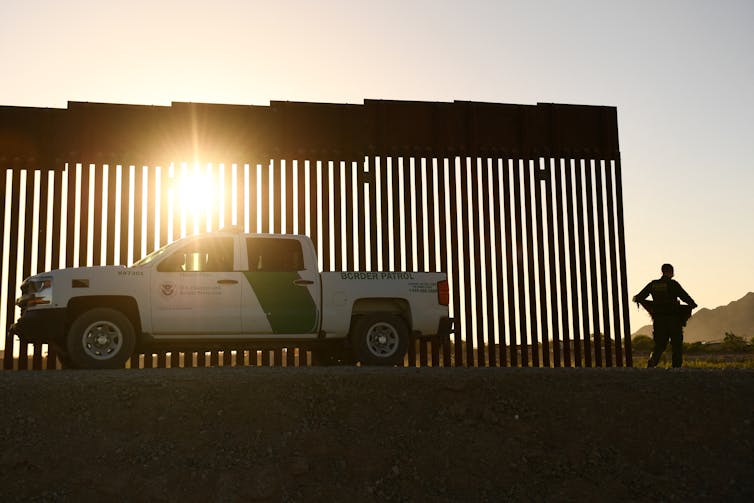Migration to the US is on the rise again – but it's unlikely to be fully addressed during the Summit
The US is convening Latin American countries in Los Angeles this week to discuss major regional issues. An expert explains 3 key things to know about one top concern – migration.

An estimated 6,000 Latin American migrants are traveling together through Mexico to reach the U.S. by foot and car, marking the largest caravan yet in 2022 of migrants traveling to the U.S. border.
Their journey coincides with the ninth Summit of the Americas, a regional meeting of country leaders from North, South and Central America that happens about once every three years. This forum grants political leaders an opportunity to discuss regional issues, like democracy and trade agreements, as a group. This year, the summit is taking place in Los Angeles and runs June 8-10.
Migration is a major issue that attendees, including President Joe Biden, will take up during the meeting, following calls for regional leaders to address the growing problems associated with it.
“These are countries collapsing from poverty and violence,” caravan organizer Luis Garcia Villagran said recently. “We strongly urge those who attend the summit … to look at what is happening, and what could happen even more often in Mexico if something is not done soon.”
As a migration expert who has spent five years researching undocumented immigrants and other immigrants with different kinds of legal protection in the U.S., I think it is important to understand what the Biden administration has done to address migration, and how this has affected U.S. foreign relations with Latin American countries.
Here are three points that can help make sense of migration trends along the U.S.-Mexico border and their influence on regional politics.

Why is migration a hot topic during the Summit of the Americas?
Migration across South, Central and North America is on the rise – and has a significant effect on almost every country in the Western Hemisphere. These effects range from the money that migrants send back to their families in their country of origin to the role they play in labor markets.
Migration in the Americas has dramatically increased over the past decade due to deteriorating political, economic and humanitarian conditions in several countries, particularly in Venezuela, El Salvador, Guatemala, Honduras and Haiti.
High rates of crime, corruption, poverty, environmental degradation and violence all influence people’s decisions to migrate. The power of drug cartels, which can be embedded in government institutions like the police, also plays a key role in prompting migration.
What’s the latest on migration to the US?
The rate of migrants crossing the U.S.-Mexico border into the U.S. has grown at a faster pace during the Biden administration than in recent years under the Trump administration.
Immigration officials encountered more than 1.7 million migrants along the U.S. border in 2021, three times the number they reported in 2020.
Government agencies have reported encountering more than 1.2 million migrants along the border in 2022. However, this number is being inflated, because migrants often make repeated attempts to cross the border. Every “encounter” is recorded as a separate incident, even if the migrant had previously been apprehended and deported.
One significant reason for the uptick in migration is the COVID-19 pandemic, which initially caused a brief lull in migration in 2020. But the pandemic’s social and economic aftershocks worsened already-fragile living conditions for many people in the Americas, pushing them to migrate.
Most of the migrants now arriving at the U.S.-Mexico border are from four countries: Mexico, Honduras, Guatemala and El Salvador.
But the countries of origin of migrants entering the U.S. have changed over the past decade. Now, large numbers of migrants from other countries like Cuba, Haiti and Venezuela – as well as migrants from Ukraine fleeing the war – routinely try to cross into the U.S. from Mexico.
What’s happened to migration under Biden?
During his presidential campaign in 2020, Biden pledged to undo former President Donald Trump’s immigration actions, and to adopt a more humane approach. Shortly after Biden took office in January 2021, he stopped construction on the U.S.-Mexico border wall and ended travel bans on people from specific countries.
The Biden administration has tried to keep its commitments to voters and immigrants’ rights activists, while also increasing spending on the Border Patrol and other government agencies focused on tracking, apprehending and processing migrants once they cross the border.
The Biden administration has attempted, but failed, due to court rulings, to lift asylum restrictions that the Trump administration implemented.
One of these asylum restrictions is an obscure public health order called Title 42 that was enacted in March 2020, ostensibly to curb the spread of COVID-19 into the U.S. This allows migration enforcement to rapidly deport migrants at the U.S.-Mexico border, without allowing them to access their legal right to apply for asylum to stay in the U.S.
Over 1.8 million deportations have taken place under Title 42. However, that number does not reflect the total number of individual people deported since 2020, as the same people crossing the border multiple times drives up the total number of reported deportations.
A second asylum restriction was a Trump-era program that requires asylum seekers to wait in Mexico while their claims are processed. In December 2021, the U.S. and Mexico announced they would restart that program in compliance with a U.S. court orderthat blocked the Biden administration’s attempt to end it.
The Biden administration is also trying to increase cooperation with Mexican and Central American authorities to stop migrants before they reach the United States.

What, if anything, could come out of this meeting?
On June 7, U.S. Vice President Kamala Harris announced $1.9 billion in commitments from companies to provide jobs for people in Mexico, Central and South America – and to potentially dissuade them from migrating to the U.S.
Migration is set to be the focus of discussions at this forum on June 10.
But the meeting, so far, has mostly attracted public attention because the U.S. did not invite the autocratic leaders of Venezuela, Nicaragua and Cuba to the event, citing human rights concerns. In response, the presidents of Mexico, Honduras and Guatemala are boycotting the forum.
Some experts have criticized the U.S. for not bringing a clear immigration policy proposal to the table at the meeting.
Regardless of any outcome regarding immigration during this Summit of the Americas, migration to the U.S. will continue.
The conditions driving migrants to the U.S. – like violence, climate change and limited work opportunities – are simply too big to solve through any one agreement or set of policy decisions.
Jack Maguire ne travaille pas, ne conseille pas, ne possède pas de parts, ne reçoit pas de fonds d'une organisation qui pourrait tirer profit de cet article, et n'a déclaré aucune autre affiliation que son organisme de recherche.
Read These Next
Medieval peasants probably enjoyed their holiday festivities more than you do
The Middle Ages weren’t as dreary and desperate as you’d think, and peasants often had weeks of…
Why are some Black conservatives drawn to Nick Fuentes?
Black Americans and white nationalists have joined forces in the past. And a number of cultural and…
As millions of Americans face a steep rise in health insurance costs, lawmakers continue a century-l
US health care policy will remain fractured until lawmakers address the core question of who is responsible…





